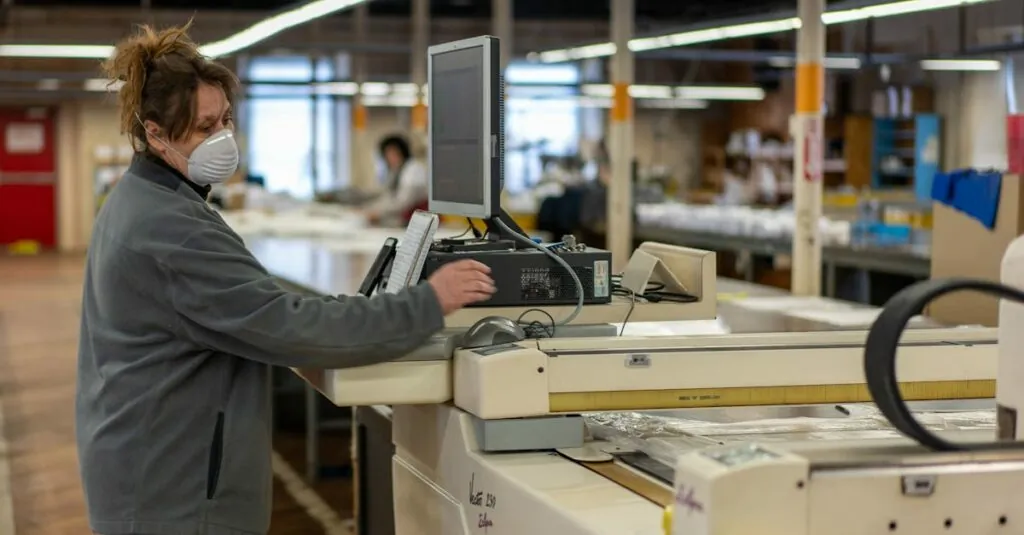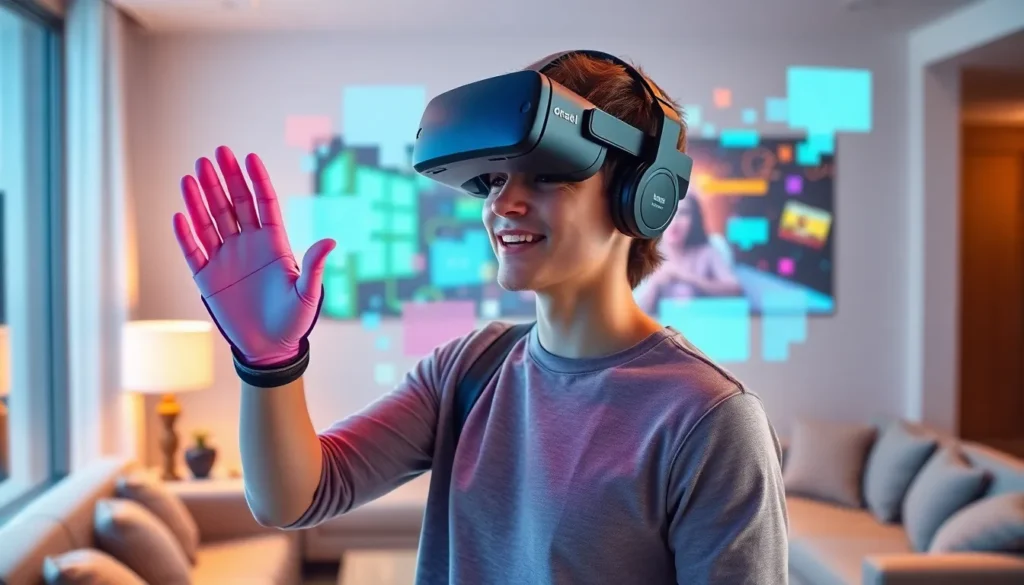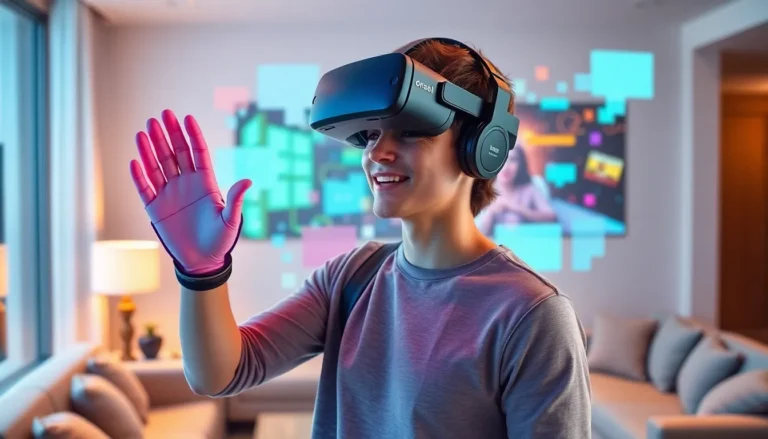Table of Contents
ToggleImagine stepping into a factory where the assembly line is as smooth as butter and the workers are equipped with superhuman skills. Welcome to the world of VR technology in manufacturing, where virtual reality isn’t just for gamers anymore. It’s revolutionizing how factories operate, making them smarter, safer, and surprisingly more entertaining.
Gone are the days of tedious training sessions and clunky machinery. With VR, employees can dive into immersive simulations that make learning feel like a video game. Picture this: a trainee donning a headset, assembling a complex machine without the risk of losing a finger. It’s not just about efficiency; it’s about creating an environment where innovation thrives. As manufacturing embraces this futuristic tech, it’s clear that VR is the secret ingredient to a more productive and engaging workplace.
Overview of VR Technology in Manufacturing
VR technology revolutionizes manufacturing by enhancing operations and training processes. Immersive environments support workers in developing skills efficiently.
What is VR Technology?
VR technology involves the use of computer-generated simulations to create interactive 3D environments. This immersive experience allows users to engage with virtual objects and spaces as if they were real. Improved hardware and software have made VR more accessible and effective in various industries. In manufacturing, VR enables realistic training for complex machinery and processes. Employees can experience virtual scenarios that replicate real-world challenges without any associated risks.
Applications in the Manufacturing Sector
Manufacturers use VR for several applications, including training, design visualization, and equipment maintenance. Training programs benefit from VR’s ability to immerse employees in realistic simulations. Design visualization helps teams collaborate more effectively by visualizing products and processes in a 3D space. Maintenance procedures can be improved through VR tutorials that guide technicians step-by-step. Lastly, VR aids in prototyping, allowing engineers to test designs before actual production. Each of these applications contributes to a more efficient, innovative, and safe manufacturing environment.
Benefits of Implementing VR Technology
VR technology significantly enhances various aspects of manufacturing. Its benefits range from improved training to increased productivity.
Enhanced Training and Skill Development
VR transforms training methods within the manufacturing sector. Employees engage in simulated environments, allowing them to practice skills safely. Immersion in realistic scenarios fosters quicker learning and better retention. Many companies report reduced onboarding time, as trainees gain hands-on experience without the risks associated with traditional training. Furthermore, workers can experiment with complex machinery in virtual settings, raising their confidence levels.
Improved Design and Prototyping Processes
Design processes also see substantial improvements through VR adoption. Engineers can visualize products in 3D before production begins, facilitating faster iterations. This visualization aids in identifying design flaws early in the development cycle. By collaborating in virtual spaces, teams streamline decision-making and enhance creativity. The capacity to manipulate virtual prototypes helps eliminate costly errors, leading to more efficient workflows.
Increased Efficiency and Productivity
VR technology contributes directly to increased efficiency and productivity. Real-time data integration allows for precise tracking of processes and performance. Workers equipped with VR tools can monitor machinery and troubleshoot problems instantly. As a result, downtime decreases, and operations run more smoothly. Overall, manufacturers experience higher output rates while maintaining quality standards.
Challenges and Limitations
VR technology in manufacturing faces several challenges that can hinder its full potential.
Cost of Implementation
Implementing VR technology involves significant financial investment. Initial expenses include purchasing hardware, such as headsets and sensors, alongside software development costs. Manufacturers also allocate funds towards integrating VR into existing training programs, which may lead to higher upfront costs. Ongoing maintenance and potential upgrades add to the overall expenditure. Decision-makers must analyze the return on investment, weighing immediate costs against long-term benefits in efficiency and safety. Smaller companies, in particular, may struggle to justify these expenses, limiting wider adoption.
Technical Limitations and Accessibility
Technical limitations present hurdles for VR integration in manufacturing. Current hardware and software may not operate optimally within all environments. Issues like latency, motion sickness, and user discomfort can affect the overall experience. Accessibility poses another challenge. Not all employees may possess the necessary technical skills or comfort with new technologies, creating a learning barrier. Companies require robust support and training to address these gaps effectively. Furthermore, Internet connectivity issues in some locations can impede successful implementation, restricting the deployment of VR solutions.
Future Trends in VR Technology for Manufacturing
VR technology in manufacturing is set to evolve with innovative trends. Increased integration with other technologies will play a key role in this development.
Integration with Other Technologies
Integration of VR with artificial intelligence enhances manufacturing processes. Machine learning algorithms improve user training experiences by adapting content based on performance. Additionally, combining VR with augmented reality provides real-time data overlays, further supporting decision-making. For instance, using VR and Internet of Things devices, workers can visualize machinery performance while interacting with simulations. This synergy fosters an interconnected environment, streamlining workflows and facilitating better collaboration across teams.
Predictions for Adoption Rates
Adoption rates for VR technology in manufacturing are anticipated to rise significantly. A recent study projects that by 2025, the global market for VR in manufacturing could reach approximately $12.6 billion. Factors influencing this growth include the increasing need for cost-efficient training solutions and improved productivity. As companies recognize the benefits of VR, the trend will likely accelerate, especially among mid-sized firms. Enhanced technology accessibility also supports wider implementation, making VR a core part of manufacturing strategies moving forward.
VR technology is reshaping the manufacturing landscape by offering innovative solutions that enhance training and operational efficiency. As companies embrace these immersive experiences they’re not only improving employee skill sets but also fostering a culture of creativity and collaboration.
The integration of VR with AI and AR is set to revolutionize how manufacturers approach problem-solving and decision-making. While challenges remain in terms of cost and accessibility the potential for growth in this sector is immense.
With projections indicating significant market expansion by 2025 it’s clear that VR will play a crucial role in the future of manufacturing. Organizations that invest in this technology are likely to gain a competitive edge in an increasingly dynamic industry.







